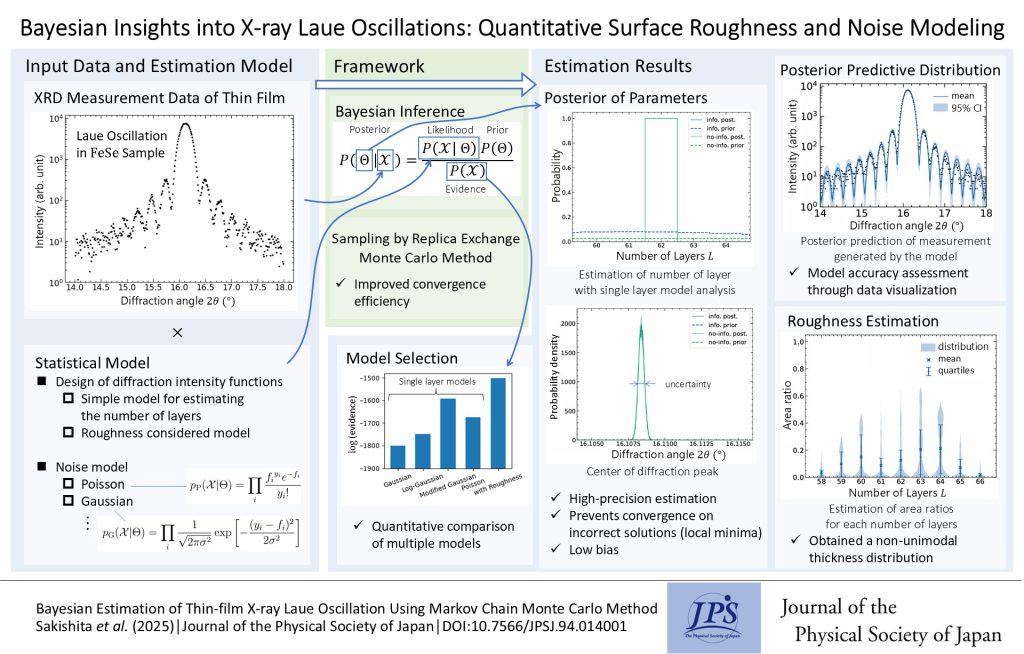Bayesian Insights into X-ray Laue Oscillations: Quantitative Surface Roughness and Noise Modeling
© The Physical Society of Japan
This article is on
Bayesian Estimation of Thin-film X-ray Laue Oscillation Using Markov Chain Monte Carlo Method
J. Phys. Soc. Jpn.
94,
014001
(2025)
.
This study adopts Bayesian inference using the replica exchange Monte Carlo method to accurately estimate thin-film properties from X-ray Laue oscillation data, enabling quantitative analysis and appropriate noise modeling.

Understanding the properties of thin films is crucial for their application in materials science, from gaining insights into physical phenomena at the nanoscale to advancing applied technologies. An effective method for analyzing these properties is X-ray diffraction (XRD), which provides detailed information about the crystal structures of materials.Among the features observed in the XRD patterns, Laue oscillations, or diffraction intensity oscillations near the main diffraction peaks, offer insights into the thickness, surface roughness, and layering of thin films.Despite their potential, Laue oscillations have not been fully utilized in quantitative analyses owing to difficulties such as the nonlinearity of the data, involvement of both discrete and continuous parameters, and risk of converging on incorrect local minima in conventional curve-fitting methods.
This study presents a novel approach to address these challenges using Bayesian statistics and the replica exchange Monte Carlo (REMC) method.Bayesian statistics enable precise parameter estimation and qualify the uncertainty associated with these estimates, which is essential for reliable data interpretation. The Markov Chain Monte Carlo (MCMC) method is a powerful statistical tool for exploring complex parameter spaces and computing Bayesian posterior distributions.REMC, an extension of MCMC, enhances convergence efficiency by running multiple MCMC simulations at different energy levels (or “temperatures”) and allowing exchanges between them. This approach mitigates the risk of stagnation in the local optima by enabling detailed exploration of the parameter space.
A key strength of this flexible Bayesian framework is its ability to evaluate different statistical models, such as those based on Gaussian and Poisson noise, directly from experimental data. This data-driven methodology allows for selecting the most appropriate noise models that best capture the data.In addition to the numerical comparison of Bayes factors, this process provides researchers with an intuitive understanding of the analysis results and builds confidence in conclusions by displaying the predictive distribution.More importantly, the principles and benefits of this methodology extend beyond Laue oscillation analysis, providing a generalizable framework for analyzing experimental data across diverse scientific fields.
To demonstrate the effectiveness of this approach, real experimental data from iron selenide (FeSe) thin films were analyzed.The results demonstrate that this method enables accurate quantitative analysis of Laue oscillations, including thickness and surface roughness, while providing comprehensive uncertainty assessment.By integrating Bayes factor-based decision-making and qualitative validation with predictive distributions, this study establishes a robust and adaptable strategy for experimental analysis across various scientific disciplines.
(Written by Yuki Sakishita on behalf of all the authors.)
Bayesian Estimation of Thin-film X-ray Laue Oscillation Using Markov Chain Monte Carlo Method
J. Phys. Soc. Jpn.
94,
014001
(2025)
.
Share this topic
Fields
Related Articles
-
Symmetry and AI: Building the Future of Physics Simulations
Magnetic properties in condensed matter
Measurement, instrumentation, and techniques
2025-2-18
Generative artificial intelligence (AI) has gained considerable attention in scientific fields. By embedding physical symmetry into AI before training, we created a faster and lighter model. Scaling improves the accuracy and unlocks the potential of physics research and applications.
-
Hyperuniform and Multifractal States in Bosonic Quasicrystalline Systems
Statistical physics and thermodynamics
Structure and mechanical and thermal properties in condensed matter
2025-2-10
Quantum states can be categorized as hyperuniform or multifractal based on electronic characteristics. This study demonstrates that bosonic quasicrystalline systems exhibit hyperuniform or multifractal quantum states.
-
Exploring Materials without Data Exposure: A Bayesian Optimizer using Secure Computation
Cross-disciplinary physics and related areas of science and technology
Measurement, instrumentation, and techniques
2025-2-6
Secure computation allows the manipulation of material data without exposing them, thereby offering an alternative to traditional open/closed data management. We recently reported the development of an application that performs Bayesian optimization using secure computation.
-
Spin-Spin Interaction Mediated by Rotational Lattice Vibrations
Magnetic properties in condensed matter
Structure and mechanical and thermal properties in condensed matter
2025-1-24
This study predicts the presence of spin-spin interactions mediated by the angular momentum of lattice vibrations, which can be long-range.
-
Unlocking Secrets of Novel Charge-Orbital States in Transition-Metal Compounds
Cross-disciplinary physics and related areas of science and technology
Electron states in condensed matter
Electronic structure and electrical properties of surfaces and nanostructures
Magnetic properties in condensed matter
Structure and mechanical and thermal properties in condensed matter
2025-1-6
A new Special Topics edition of the Journal of the Physical Society of Japan features articles exploring special transition-metal compounds that exhibit novel charge-orbital states.




